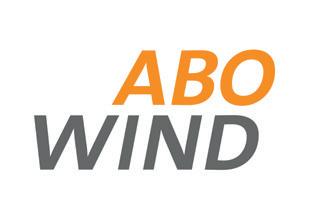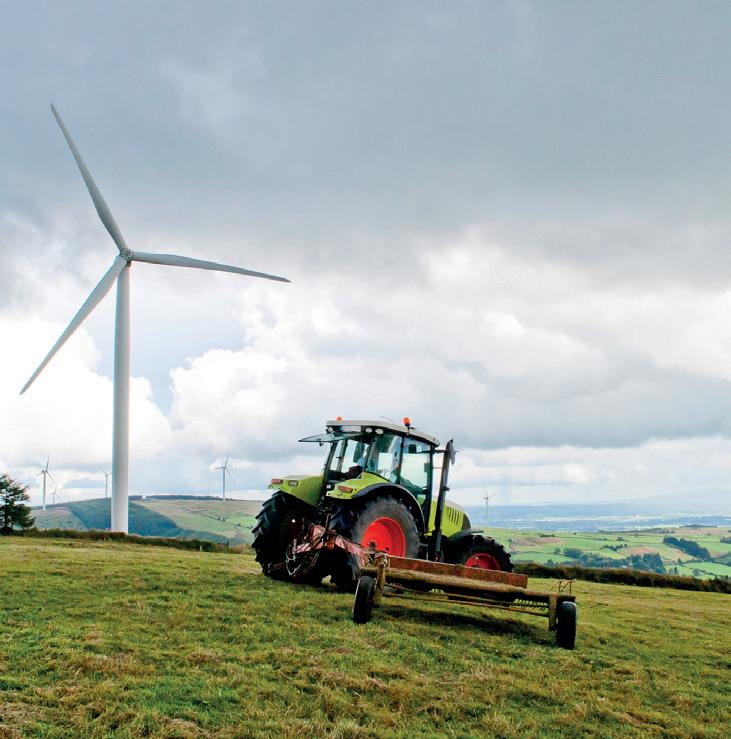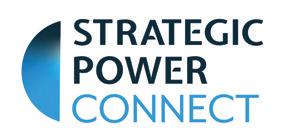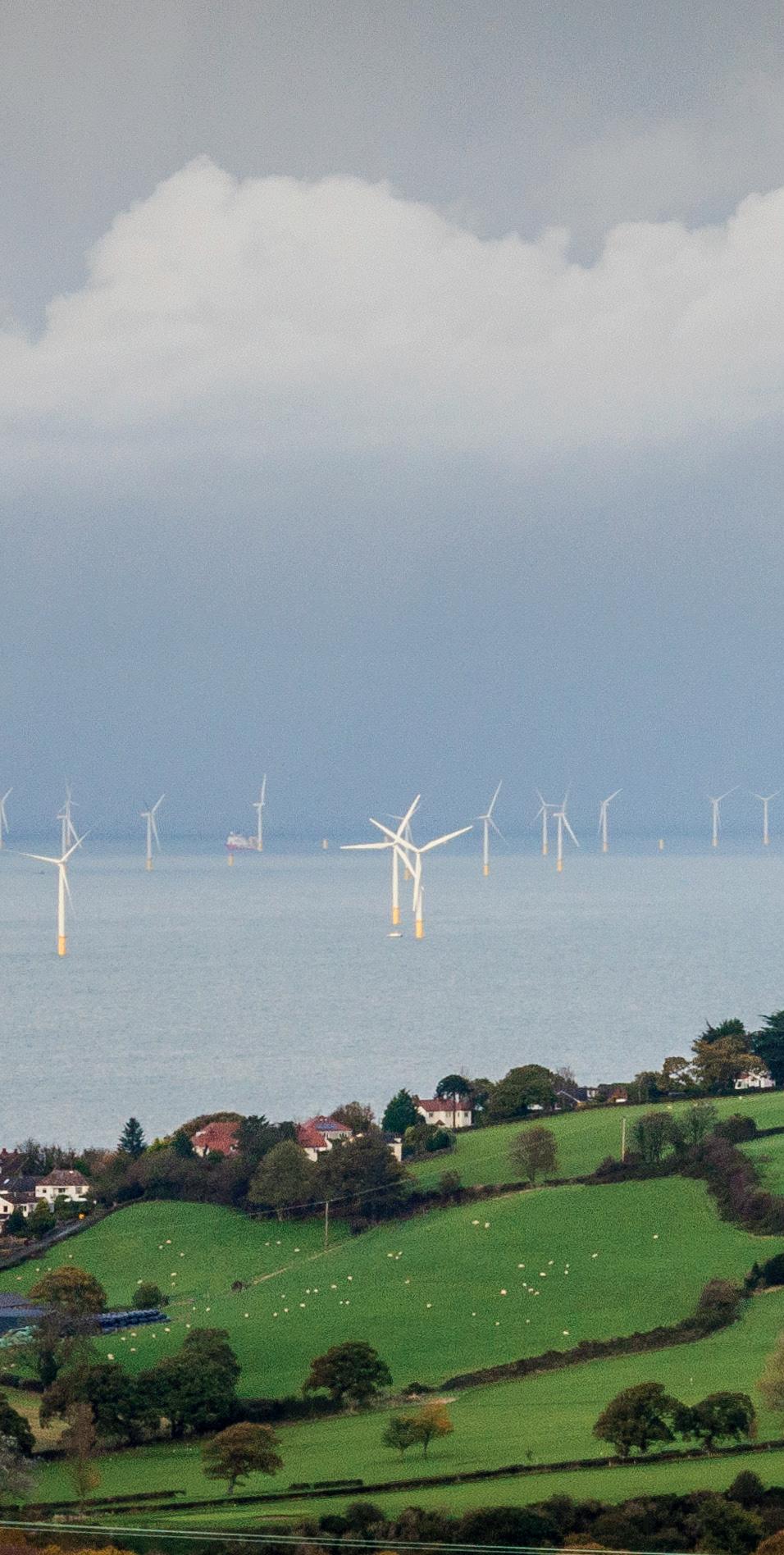Future of Energy

Q3 2023 | A promotional supplement distributed on behalf of Mediaplanet, which takes sole responsibility for its content



“The Government has committed to significantly reducing harmful emissions across all sectors of our economy.”
Eamon Ryan, Minister for the Environment, Climate and Communications Page 02
www.businessnews.ie

“Investing in home-grown green energy and energy efficiency solutions begins by delivering immediate energy cost reductions.”

Diana Vaz, Renewable Research Technologist, Irish Manufacturing Research Page 06 RENEW THE WAY THE WORLD IS POWERED Learn more at www.statkraft.ie
How biofuels can help Ireland hit its emissions reduction targets
If Ireland is to meet its targets by 2030, a range of renewable energy solutions will need to be brought into the mix — including biofuels.
Ireland’s target is to reduce its greenhouse gas emissions by 51% by 2030. To achieve this, it needs to adopt a range of renewable energy solutions. These include biofuels, explains John O’Leary, Managing Director of Inver Energy, part of the Greenergy Group.


Environmental benefits of biofuels from waste products
“Biofuels are made from biological materials such as food crops, agricultural waste or waste oils,” explains O’Leary. “If renewable biofuels are used instead of fossil fuel, there is immediate scope for reduction of greenhouse gas emissions, which is why we have adopted biofuels in our own fleet.”
Moreover, biofuels such as those supplied by Inver are derived from waste products and are a win-win for the environment. Take used cooking oil, a waste that can be challenging to dispose of safely and may end up in the sewer as a fatberg. However, once converted into HVO (hydrotreated vegetable oil), it can be used to run everything from commercial boilers to HGVs. “Another benefit of biofuels derived from waste is that they have a lower land impact than biofuels made from crops, not competing with food chains,” explains O’Leary.
How retrofitting can make our homes warmer and
to heat
Retrofitting — home energy efficiency upgrades — can help people manage or reduce the amount of energy used in homes and is being carried out to reduce harmful emissions.
The Government has committed to significantly reducing harmful emissions across all sectors of our economy. The Climate Action Plan sets out sectoral targets, including those aimed at reducing the amount of energy that we use in our homes. This is already happening through an ambitious programme of retrofitting, requiring a significant scaling up of activity in the sector.
Home retrofitting targets and upgrading energy
2. The National Home Energy Upgrade Scheme and Community Energy Grant Scheme are aimed at homeowners wishing to undertake a whole-house energy upgrade, achieving a Building Energy Rating of at least B2.
3. The Warmer Homes Scheme provides fully funded upgrades to lower-income households.
Expanding access to new forms of biofuels
One of the biggest barriers to increasing biofuel use is the availability of feedstock (ie. the raw material converted into biofuel).
“The whole world is competing for certified and affordable biofuels,” he says. “We must ensure access to the feedstocks needed, and the setting of advanced biofuel targets in the Renewable Energy Directive will assist in that regard. It challenges the players in the market and incentivises the development of new forms of biofuels from non-food feedstocks.”
“We are committed to providing a mix of biofuels to our customers as this helps in reducing carbon emissions immediately and is an integral element of the transition to renewable energy sources,” says O’Leary. “This is key to achieving Ireland’s emission reduction targets.”
John O’Leary Managing Director, Inver Energy
WRITTEN BY Tony Greenway
Last year, we surpassed our target to retrofit 27,000 homes. This year, we aim to go further, with a target of 37,000 retrofits and a record €356 million in funding. In the first six months, we’ve supported almost 22,000 more retrofits, with demand and application levels setting us up for more retrofits next year and onto 2030. The Government introduced support packages to make it easier and more affordable for homeowners to undertake home energy upgrades. Here’s an outline of what’s available through the Sustainable Energy Authority of Ireland (SEAI) to suit your home upgrade needs and budget best:
1. The Better Energy Homes Scheme (Individual Grant Scheme) allows homeowners to take a step-bystep approach or self-manage the project — a good option to get attic insulation or heating controls installed before winter.
Wider advantages of home retrofitting Home retrofitting makes it warmer and more efficient, and it has wider benefits. Reducing energy usage and switching to electricity for heating makes Ireland less reliant on imported fossil fuels, improving our energy security. Moreover, the Government’s retrofit programme creates new green jobs in the construction industry as well as long-term careers in the retrofit sector.
The Government is also giving people more control over their energy bills through the Microgeneration Support Scheme. This enables people to generate their own renewable electricity, selling back any excess to the national grid. Since its launch, over 2,000 applications every month have been made across both the domestic and non-domestic solar PV (photovoltaics) schemes operated by SEAI.
More people are joining the renewable energy revolution, helping them manage their electricity costs and giving them the means to reduce their emissions and support the electricity grid. You can join them. See the full details of the supports and grants available at seai.ie/grants
Business Development Manager: Lucy Harris Managing Director: Alex Williams Country Manager - Ireland: Ross Bannatyne | Head of Print & Design: Thomas Kent Designer: Aimee Rayment Content Editor: Angelica Hackett O’Toole | Head of Digital Operations: Harvey O’Donnell Paid Media Manager: Jonni Asfaha Social & Web Editor: Henry Phillips Digital Assistant: Carolina Galbraith Duarte All images supplied by Gettyimages, unless otherwise specified | Contact information: uk.info@mediaplanet.com or +44 (0) 203 642 0737
Project Manager: Cian Fitton cian.fitton@mediaplanet.com
02 READ MORE AT BUSINESSNEWS.IE AN INDEPENDENT SUPPLEMENT FROM MEDIAPLANET WHO TAKE SOLE RESPONSIBILITY FOR ITS CONTENT MEDIAPLANET
cheaper
@BusinessnewsIE @MediaplanetUK Please recycle
Eamon Ryan Minister, Department of Environment, Climate and Communications
Home retrofitting makes it warmer and more efficient, and it has wider benefits.
Paid for by Inver Energy Find out more at inverenergy.ie
The whole world is competing for certified and affordable biofuels.
The future of renewable energy: how to lead the way in engineering
In an era where sustainable solutions are paramount, renewable energy stands at the forefront of the global transition towards a greener future.
H&MV Engineering, with its extensive project portfolio and unwavering commitment to excellence, has firmly established itself as a leading EPC (engineering, procurement and construction) contractor in the renewable energy sector. From wind farms to solar and battery storage developments, its expert crews are at the heart of projects across Europe, driving the clean energy revolution forward.


Comprehensive service offerings
The contractor has end-to-end service offerings that cover every phase of a renewable energy project. From conceptual design
to meticulous planning, seamless delivery and final energisation to operations and maintenance, they provide clients with a comprehensive and reliable experience. This fullservice approach instils confidence in clients, knowing they are partnering with a brand they can trust to deliver exceptional results.
Global reach for a sustainable future
Their impact on the renewable energy sector extends far beyond national borders. With a dedicated focus on both national and international projects, they are driving the renewable energy agenda on a global scale. By leveraging their expertise and resources,
the contractor is contributing significantly to the reduction of carbon footprints worldwide while simultaneously spearheading the transition towards a sustainable energy landscape.
Pioneering innovation and excellence
In an ever-evolving field like renewable energy, innovation is key. H&MV Engineering remains at the forefront of technological advancements, consistently pushing the boundaries of what is possible in the realm of clean energy solutions. Their teams of experts are not only well-versed in current industry standards but also dedicated to staying ahead of the curve, ensuring that clients receive the most cuttingedge and efficient renewable energy systems available.
Call to a sustainable future
As we stand on the cusp of a new era in renewable energy, we must envision a future powered by clean, sustainable sources. H&MV Engineering encourages us to seize the opportunities that lie ahead, both within the company and in the broader renewable energy sector. With each project, they aim not only to deliver exceptional results but also to inspire a collective commitment to a more sustainable world.
An online conference aims to showcase innovative energy research projects and spark discussion about how best to achieve Ireland’s clean energy goals.
The world has no choice, stresses Kerrie Sheehan, Head of Research and Technology at Sustainable Energy Authority of Ireland (SEAI). We must create a cleaner, more sustainable energy future. “Unfortunately, there’s no silver bullet for this,” she admits. “We’re going to need a wide range of solutions to help us get to where we need to go.”
Developing clean energy solutions in Ireland

Naturally, finding those solutions will require a serious amount of academic, industrial, blue sky and pre-commercial research — which is where SEAI comes in. With a mission to be at the heart of Ireland’s energy revolution, they work with householders, businesses, communities and government to change the way we think about, generate and use energy. One part of its remit is to coordinate and fund energy research in Ireland. It has awarded over €50 million
in research grants to a variety of innovative national energy research development and demonstration (RD&D) projects.
“Energy research is vital,” says Sheehan. “It will accelerate the development and deployment of innovative energy products, processes and systems as well as help overcome barriers to market uptake. It is essential that we grow Ireland’s capacity to access, develop and apply international-class RD&D as well as provide energy policy guidance and support.”
Informing energy policy development with up-to-date expertise
In 2019, SEAI hosted its first National Energy Research and Policy Conference to gather experts dedicated to helping Ireland achieve its long-term clean energy goals. “We needed a forum where policymakers, academic experts and energy industry and community representatives could share research findings, policy ambitions and insights. We put a high value on

networking and lively discussions,” explains Sheehan. “We have focused on pivotal areas of electricity, heat, transport and societal change, with esteemed national and international contributions.”
This year’s online conference surrounds the increasingly topical subject of energy security. Achieving a sustainable and secure energy future for Ireland requires significant research, innovation and collaboration to identify solutions that work for society.

The conference is a way of bridging innovation and ensuring that energy policy development and implementation is informed by the most current expertise available.
“People have different concepts of energy security, depending on their specialist areas,” says Sheehan. “Delegates will gain a broader understanding of the topic and what it means from different perspectives. Holding the event online makes it accessible and sustainable, helping us secure excellent overseas speakers alongside national experts.”
While clean energy innovation is vital, so is public buy-in, notes Sheehan. “Decarbonisation will require seismic societal change,” she says. “We have to inform with facts through events like this to ensure that people embrace solutions identified through funded research.”

MEDIAPLANET READ MORE AT BUSINESSNEWS.IE 03 AN INDEPENDENT SUPPLEMENT FROM MEDIAPLANET WHO TAKE SOLE RESPONSIBILITY FOR ITS CONTENT
How funded research is facilitating Ireland’s clean energy transition
Paid for by SEAI Find out more at seai.ie
Kerrie Sheehan, Head of Department, Research and Technology, Sustainable Energy Authority of Ireland (SEAI)
WRITTEN BY Tony Greenway
Find out more at hmvengineering.com Paid for by H&MV Engineering
Enda Molloy Group Development Director, H&MV Engineering
WRITTEN BY Tony Greenway
Brighter future for solar in Ireland: growth, challenges and opportunities
With over 680MW (megawatts) of installed capacity, solar has demonstrated its importance in Ireland’s decarbonisation strategy. Persistent barriers to the deployment of solar must be lifted to guarantee a bright future for Ireland.
Solar’s recent growth in Ireland has been revolutionary. ESB (Electricity Supply Board) Networks recently stated that solar is ‘the fastest growing renewable power source in Ireland.’ From 0% last year, Sustainable Energy Authority of Ireland statistics showed a day in May when solar provided 10% of the country’s electricity.
Successes in solar energy
This exciting progress was unlocked by two changes: (1) removal of barriers to rooftop solar and (2) a route to market emerging for utility-scale ground mount solar. Consumers are placing solar on their homes and businesses at an unprecedented rate. Domestic users are installing an average of 500 systems a week. Commercial players are installing not only at kilowatt scale but megawatt scale.
Complementing this rooftop growth has been the long-awaited flourishing of the substantial utility-scale pipeline developed by the solar industry. A key enabler has been the Renewable Electricity Support Scheme auctions. The growing confidence in solar’s potential was reflected by the Government increasing the country’s solar PV (photovoltaics) target from 1.5–2.5 gigawatts (GW) by 2030 to 5GW by 2025 and 8GW by 2030. Solar is not a fringe technology but a significant part of Ireland’s decarbonisation toolkit, alongside storage and wind.
How renewable energies benefit the planet — and local communities
To solve the climate crisis, fossil fuels need to be phased out — fast. Ireland has set ambitious climate goals: 80% of Irish electricity is planned to be renewable by 2030.
In recent months, the climate crisis has wreaked havoc all over Europe, from devastating floods and catastrophic wildfires to extended heatwaves.
Beneficiaries from renewable energies
“People are worried how expensive the energy transition will be, but given the accelerating climate crisis, it’s obvious that the alternative would be much more expensive,” says Dr Joe Jellie, Director of ABO Wind Ireland Ltd.


Technological advances have made renewables much cheaper in recent years. Furthermore, a renewable energy system is decentralised, so many people profit from a single wind or solar farm. “Renewable projects provide landowners with a steady and predictable income,”
Delivering infrastructure
The question is not whether solar will scale but how large an industry can be built in Ireland. To facilitate that growth, fundamental decisions need to be taken by the state. We must build the network to support a zerocarbon system — quickly. Building that grid will deliver the green electrons needed to shape and power the future clean economy of Ireland.
Planning remains a challenge. The system requires resourcing. For example, the national planning authority, An Bord Pleanála, is struggling to decide on solar planning appeals within the mandated 18 weeks; currently averaging close to 36 weeks, with some cases taking over 70 weeks. Approximately 90% of projects are successful in that process, which suggests something needs fixing.
Developing green economy
There is no pathway to a sustainable energy future that does not involve Irish farmers. Inconsistencies in the policy framework unnecessarily place these sectors at odds. For example, our taxation framework is not supportive of multiple land uses, such as growing food and generating solar in the same field.

Ireland has among the highest-cost renewables in the world. We would welcome a review of the policy and state factors influencing those costs. We incur a higher price than needed for our energy transition. The future is bright for solar in Ireland if we grasp the opportunity.
Founded in Germany, the family-run company opened its Dublin office in 2008, which has a current staff of 12. “We are now a global company with a thousand colleagues and have developed projects with more than five gigawatts. However, our local presence is what makes these projects successful. Getting to know our project partners and building strong relationships is crucial.” ABO Wind Ireland is growing, and the company is seeking new staff — especially engineers, project managers and town planners.
explains Dr Jellie. His company contracts regional companies for the construction of wind farm access tracks, turbine foundations and electricity substations. Local communities also benefit from wind farms by way of a Community Benefit Fund, which is dedicated to community projects.
Local engagement is essential
Before a wind farm is commissioned, many hurdles have to be cleared. It usually takes 5 to 10 years until the turbines are connected to the grid. “We have been developing wind farms since 1996, so we have gained a lot of experience from 16 different countries over the years,” says Dr Jellie.
A new energy system is evolving
While onshore wind has been the company’s main focus in Ireland, energy storage is becoming more important. In 2021, ABO Wind commissioned its first 50-megawatt battery project in Kells, Northern Ireland and currently has several more battery projects planned on the island of Ireland.
They are also working on solar and hydrogen projects internationally and could apply this experience in Ireland when the opportunity arises. “It’s an exciting time to be working in renewables with wind, solar, batteries and hydrogen creating a reliable and clean energy supply,” says Dr Jellie.

04 READ MORE AT BUSINESSNEWS.IE AN INDEPENDENT SUPPLEMENT FROM MEDIAPLANET WHO TAKE SOLE RESPONSIBILITY FOR ITS CONTENT MEDIAPLANET
Conall Bolger Chief Executive Officer, Irish Solar Energy Association
Find out more at abo-wind.ie Paid for by ABO Wind
Dr Joe Jellie Director, ABO Wind Ireland Ltd.
Taking the lead to enable access to affordable renewable energy in Ireland
A renewable energy developer in Ireland is working to help the nation secure sustainable energy with its new leadership.
An energy supply and renewables expert, Liam Faulkner, is appointed as CEO of Strategic Power Connect (SPC). Their mission is to help commercial and industrial businesses access affordable, renewable and secure energy while meeting tightening decarbonisation legislation.



Affordable and sustainable energy
The company designs and installs on-site renewable energy systems to enable major energy users to reach their sustainability goals. Users can secure energy supplies at a set price through a power purchase agreement, ensuring costs can be managed and energy price spikes avoided. It also ensures security and
provenance of supply by producing energy on-site and removing reliance on the grid. Crucially, it offers a fully funded model where users can avoid upfront capital costs, as well as offering an outright sale option.
Providing renewable energy sources Faulkner’s appointment marks the next stage of growth for the company, as it plays a central role in global decarbonisation by helping large energy users access affordable and secure renewable energy. “I’m proud to have joined Strategic Power Connect, a company which is playing a major role in decarbonising industry. At a time when large energy users are under pressure to reach increasingly demanding sustainability goals, reduce costs and
ensure security of supply, our offer is innovative and timely.
“Couple that with the fact we can provide on-site renewable sources for no upfront capital expenditure, and SPC makes a compelling case.” The company was founded by Paul Carson in reaction to growing concern for energy provenance, ESG and climate change. It is part of the Strategic Power Group, which also houses Strategic Power Projects, an all-Ireland renewable energy company established to support ambitious government plans to reduce emissions through the development of large-scale solar photovoltaic and better energy storage systems.
Goals and meeting sustainability targets Carson says: “Liam is a true expert in the renewable energy field and will help us to expand our reach to high-energy users, both locally and further afield, and to play our part in global decarbonisation.
“We have already uncovered huge demand for our offering from large energy users looking to reduce their energy costs while, more consciously, making their transition to decarbonise their energy outputs. With Liam’s leadership, we will be able to help industry and other large energy users to bolster their resilience, meet emissions targets and secure a more prosperous and sustainable future for all.”
Robust grid infrastructure
The 2030 goal for the green energy transition can seem like a long way off. However, as the end of the decade looms, reaching our renewable energy targets becomes increasingly urgent.
Grid-scale batteries and synchronous compensators to store power and stabilise the grid are necessary to ensure the energy transition. They allow EirGrid to turn off fossil-fuelled power stations when renewables are supplying Ireland’s electricity demand. Meanwhile, the development of green hydrogen could be key for sectors that are difficult to decarbonise and where solutions such as electrification are neither feasible nor cost-effective. We also need more robust grid infrastructure including power lines, underground cables, substations and additional interconnectors to UK and Europe — beyond what is already planned.
Kevin O’Donovan Managing Director, Statkraft Ireland

We are up against the clock to generate 80% of our electricity from renewable sources. While Ireland is undoubtedly on the right path, we must go faster. Statkraft understands the need to accelerate the energy transition and is helping to drive the country towards a carbon-free electricity system. It is developing renewable technologies including onshore and offshore wind, solar, battery storage and grid services.
Leading the charge for green energy transition Onshore wind has been the backbone of the country’s decarbonisation journey since the early 1990s when
the first wind farm was built. Today, there are nearly 400 wind farms across the island — a reflection of the expertise developed over the past three decades.
Solar power is now a growing part of Ireland’s renewable energy mix. Statkraft is leading the charge on its rollout by building the country’s largest solar farm in Ballymacarney, Co. Meath while constructing several additional solar projects. Other technologies are on the horizon, too. The State’s first offshore auction, ORESS 1, took place in May. Four projects (including the Statkraftowned NISA wind farm) with a combined capacity of almost 3.1 gigawatts were awarded contracts.

Monumental effort with decision-makers
We have the technologies, the know-how and natural resources to meet our 2030 goals. However, it will take a monumental effort, not just by the renewable energy industry but by the Government and bodies like An Bord Pleanála, local authorities, EirGrid, the Commission for Regulation of Utilities (CRU) and the Department of Environment, Climate and Communications. The end of the decade is closer than we think. Therefore, working together to accelerate the deployment of renewable energy projects is the only way we will reach our destination with time to spare.
MEDIAPLANET READ MORE AT BUSINESSNEWS.IE 05 AN INDEPENDENT SUPPLEMENT FROM MEDIAPLANET WHO TAKE SOLE RESPONSIBILITY FOR ITS CONTENT
The year 2030 is closer than we think: why we must accelerate Ireland’s energy transition
Paid for by Statkraft Find out more at statkraft.ie
Liam Faulkner
CEO, Strategic Power Connect
Paid for by Strategic Power Connect
The Strategic Power Group is a market leader in renewable energy development in Ireland, with a background in planning and site development since 2003. For more information, visit strategicpower.co
New records have already been set for January, April and July of this year while the average monthly wholesale electricity price in July was at its lowest level since 2021.
Benefits of wind energy
Every day, Irish wind farms are protecting consumers while cutting the carbon emissions that are driving the climate emergency. The faster we can build and connect new onshore wind farms to the electricity system, the more secure we make Ireland’s energy supply, the more money we put back into people’s pockets and the more we cut our carbon emissions.
Momentum is also growing behind Ireland’s offshore wind energy revolution with the first six offshore projects due to enter the planning system before the end of the year.
Rolling out renewable energy in Ireland
The best way out of this energy crisis is to accelerate the development of renewable energy. We must ensure more of our power is provided here, at home, creating Irish jobs and supporting local communities. However, there is a growing backlog of projects stuck in An Bord Pleanála waiting for a decision — for years, in some cases. The
resources are simply not there or in agencies like the National Parks & Wildlife Service or the newly formed Maritime Area Regulatory Authority.
We need the right people, with the right expertise, to make the right decisions. We need them to ensure that these projects are built and that the public has confidence the system is working properly.
The Government’s plans to reform the planning system, by putting in place mandatory timelines for decisions, need to be fully supported. There must be total political backing right across the Oireachtas for EirGrid’s strategy to reinforce the country’s electricity grid.
Prioritising a reliable planning system
We cannot build the wind farms we need without a planning system that is fit for purpose, and we cannot get the power to where it is needed without a much stronger electricity grid. Both of these issues must be top priorities for all political parties ahead of this year’s budget and elections coming in 2024.
The quicker we can overcome these challenges, the faster we will be able to build the wind farms we need — on and offshore — to secure Ireland’s energy supply, support local communities and create thousands of green energy jobs.
Sustainable energy solutions provide numerous benefits to companies. With a wide array of technologies available for adoption, it is crucial to identify the most suitable options for each industrial site.
Clean energy solutions aid companies in achieving decarbonisation targets, demonstrating a commitment to environmental sustainability and corporate social responsibility, enhancing funding access, attracting responsible stakeholders and fostering positive public relations. Therefore, the benefits of embracing clean energy solutions extend well beyond the environmental sphere.
Why we need sustainable energy solutions
Industries’ huge dependence on energy providers constitutes a significant external risk. Energy markets are susceptible to several factors: global events that disrupt supply chains and infrastructures, economic conditions and geopolitical events are a few examples. These elements impact energy commodities’ prices and availability, ultimately influencing the price a company pays to operate.
Investing in home-grown green energy and energy efficiency solutions begins by delivering immediate energy cost reductions. It also decreases energy dependence — protecting businesses from volatile energy prices, providing financial stability and supporting business growth and competitiveness.
Key technologies in EU strategy for net zero industry

The Net-Zero Industry Act recently emerged as one of the pivotal initiatives in the EU’s energy regulatory landscape. Europe is a net importer of clean energy technologies. To ensure future resilient energy systems, the Act aims to boost the EU’s manufacturing of key clean energy technologies by simplifying regulations and fostering a favourable investment climate.
The Act prioritises the following technologies, specifically targeting renewable energy production and energy efficiency:
• Solar
• Electrolysers and fuel cells (for green hydrogen production and storage)
• Wind
• Sustainable biogas/biomethane
• Energy storage
• Carbon capture and storage
• Heat pumps and geothermal
• Grid technologies
How to find the most suitable solution
Selecting the best solution(s) for an industrial site depends on understanding its unique settings: operation conditions, available resources and constraints. Thorough assessments are crucial before procuring energy solutions — to understand their technical and economic implications.
There is a wide range of solutions available, which can be overwhelming for companies to assess without the in-house expertise or the budget for hiring consultants to go through them all. Budget and space constraints further restrict the decision-making process. To mitigate risks, companies often analyse only commonly used solutions, potentially missing opportunities.
As an example of how to overcome this challenge, IMR conducted an EI-funded project, RES Feasibility Toolkit, which covers 11 technology groups. With high-level feasibility assessments, businesses can be pointed in the right direction and find the sustainable energy solution(s) that best aligns with their goals.

06 READ MORE AT BUSINESSNEWS.IE AN INDEPENDENT SUPPLEMENT FROM MEDIAPLANET WHO TAKE SOLE RESPONSIBILITY FOR ITS CONTENT MEDIAPLANET
Wind energy in Ireland: planning and grid must be top priorities
Investing in sustainable energy: how to make sure it’s a long-term benefit
Irish consumers avoided paying €2 billion for gas last year because the country’s wind farms provided a third of our electricity.
Diana Vaz Renewable Research Technologist, Irish Manufacturing Research
Justin Moran Director of External Affairs, Wind Energy Ireland
We need the right people, with the right expertise, to make the right decisions.
Energy storage: what Ireland needs to achieve its zero energy aims
Energy storage is a critical enabler of Ireland’s transition to renewable technology. It will be a necessary part of meeting extremely challenging decarbonisation targets.
Like many other countries, Ireland has set itself challenging renewable energy and decarbonisation targets. These include increasing the share of renewable electricity up to 80% by 2030 and aiming for net zero by 2050.
“It’s certainly ambitious,” agrees Brian Kennedy, Head of Client Origination at ElectroRoute, a Dublin-based energy trading and optimisation business, which operates in several markets, including Japan. “But we won’t get anywhere without ambition.”

Energy storage enables renewable technology ElectroRoute’s vision is to make net zero a reality by solving the commercial mechanics of
a decarbonised energy system. It provides trading services to renewable assets including wind farms, solar farms, and batteries. “We don’t develop assets ourselves,” says Kennedy. “Our purpose is to offer our clients a route to market, keep them ahead and deliver them the best outcomes.”
A key near-term focus for the company is energy storage, which it sees as critical to Ireland’s transition to renewable technology. Without it, those all-important targets could be missed.
“First, storage technology is vital because it’s a way of taking cheap, green electricity when demand for it isn’t there — and keeping it in reserve for when it is,” explains Kennedy. “Secondly, there are times when cables and wires simply can’t
move power because of too much congestion at a local level. Energy storage is the perfect technology to mitigate congestion.”
A flexible portfolio — and a flexible attitude
Kennedy stresses that ‘flexibility’ must be everyone’s watchword if Ireland is to achieve its zero-energy goals. “There isn’t one technology that will get us to net zero,” he says.
“We are going to need a range of sustainable options — a portfolio of different low-carbon generation assets that can react flexibly and in real time to manage Ireland’s changing energy needs.”
He also recognises that ElectroRoute must be flexible and nimble so that it can stay ahead of a technological trend or emerging market. “We see the acute requirement for demand flexibility, which will require our trading and operations teams across power and gas to combine for single solutions,” says Kennedy.
“For example, supporting a Large Energy User to optimise a site, which includes energy storage, gas generators fuelled by biomethane — and trading and hedging power on behalf of the core electrical demand. We’re positioned to provide those solutions.” He believes the pace of change towards renewables is accelerating. “I’m confident that we’ll see significant changes over the next three to seven years,” he says.
investment in offshore winds. The secondary economic benefits include attracting economic investment, leading to more jobs and a higher standard of living for local communities.
How does this affect household energy bills?
Ireland needs to attract low-cost investors to ensure that it can decrease the cost of developing and constructing renewable energy, explains KPMG partner James Delahunt.



What should policymakers consider when targeting investment in Ireland’s energy sector?
James Delahunt Partner, KPMG
 WRITTEN BY James Martin
WRITTEN BY James Martin
Ireland must design policy that attracts the lowest cost of capital investors to the Irish market. Ireland is competing in an international market for international capital, where lots of other countries are decarbonising. The Renewable Energy Support Scheme (RESS) was attractive given its 15-year Government-backed contracts. However, the lack of indexation in the recent Government-backed auctions — RESS 1 and RESS 2 — resulted in significant investors in the pension fund community not being interested as they couldn’t match index-linked liabilities with index-linked cashflows. If Ireland attracts the right investment, it
will mean cheaper capital, which translates to lower infrastructure costs and ultimately cheaper energy costs for consumers.
What is the total investment requirement to achieve renewable energy targets?
Ireland’s Climate Action Plan target of 80% Renewable Electricity by 2030 will require at least €40 billion of capital to deliver the projects and grid infrastructure required. This is an unprecedented level of capital investment into a single industry but also an economic opportunity for communities and businesses throughout the country. For example, regional towns near the coasts benefit from port infrastructure as a result of
Households across Ireland have experienced unsustainably high energy bills over the past year. In fact, electricity costs in Dublin are the highest in the EU, with Irish consumers paying over €800 annually in excess of the EU average. The shift to renewable technologies will allow for cheaper energy that is independent of geopolitical events that trigger price hikes.
Is this also relevant for businesses?
Yes, a greater level of renewable energy in the Irish energy system will result in more stable electricity prices for businesses as well as consumers. Additionally, there is an increasing demand from businesses that want to power their businesses with renewable sources to reduce their overall carbon footprint, as many businesses develop their sustainability strategies to play their part in addressing the climate crisis. We are seeing this in the form of uptake in corporate power purchase agreements where energy users contract directly with an energy generator, and we expect this trend to continue.
MEDIAPLANET READ MORE AT BUSINESSNEWS.IE 07 AN INDEPENDENT SUPPLEMENT FROM MEDIAPLANET WHO TAKE SOLE RESPONSIBILITY FOR ITS CONTENT
More jobs and affordable energy for Ireland by attracting low-cost investors
Find out more at kpmg.ie/ sustainable futures
Sponsored
by KPMG
Find out more at electroroute.com Paid for by ElectroRoute
Brian Kennedy Head of Client Origination, ElectroRoute
WRITTEN BY Tony Greenway
Decarbonisation drive: how to embrace energy efficiency through digitisation


As the world prioritises decarbonisation and reducing greenhouse gas emissions, energy efficiency emerges as a vital component. Digitisation can revolutionise the energy industry, paving the way to a more sustainable future.
Decarbonisation is now a strategic imperative for companies, and energy efficiency plays a crucial role in these efforts. It means reducing greenhouse gas emissions and combatting the climate crisis while making economic sense; as the saying goes: ‘the cheapest kilowatt is the one you do not use.’
enables smart energy management systems with realtime monitoring and data analytics. These unveil energy consumption patterns, inefficiencies and enhancements. Integration of artificial intelligence and machine learning allows predictive analysis, using historical data to selflearn and optimise systems, reducing energy consumption and increasing onsite renewables’ use.
David McCormack Director of Sustainable Manufacturing, Irish Manufacturing Research
Link between digitisation and energy efficiency
In an era of rapid technological advancements, energy efficiency is critical. Our global population and energy consumption rise. To mitigate the climate crisis and resource depletion, we must turn to digitisation as the key to unlocking energy efficiency.
Digitisation, or ‘digital transformation,’ integrates advanced technologies, data analytics and automation across sectors. Applied to the energy industry, digitisation revolutionises energy production, distribution and consumption. At Irish Manufacturing Research, we focus on three strands of digitisation and energy efficiency: visualisation, optimisation and excellence.
Visualisation: the baseline to start from Industrial Internet of Things (IIoT) and smart devices foster seamless connectivity between energy-consuming devices and central management systems. This enables granular and bottom-up energy monitoring, providing data to stakeholders for informed decisions.
Optimisation: increasing efficiencies
Once you have the data, you can analyse it and identify optimisation opportunities. Digitisation at the factory level
At the grid level, digitisation enables energy storage, renewable integration, demand response and load management. Algorithms and predictive modelling, for example, can better integrate solar and wind energy into the grid, responding dynamically to weather conditions and demand fluctuations. Digital tech optimises renewable energy storage and distribution, enhancing grid stability and reducing fossil fuel reliance. Realtime communication empowers energy providers with efficient demand response mechanisms and load management, easing grid strain.
Excellence: streamlined industry standards
Digitisation streamlines energy audits, reporting and benchmarking against industry standards through automated data collection and analysis. This not only identifies areas for improvement but also nurtures competition and innovation in the quest for greater energy efficiency.
By embracing digital technologies, we can foster a smarter, more sustainable energy ecosystem that minimises waste, optimises consumption and reduces greenhouse gas emissions. Governments, businesses and individuals must embrace and harness digitisation’s transformative power for a sustainable future.
08 READ MORE AT BUSINESSNEWS.IE AN INDEPENDENT SUPPLEMENT FROM MEDIAPLANET WHO TAKE SOLE RESPONSIBILITY FOR ITS CONTENT MEDIAPLANET
In an era of rapid technological advancements, energy efficiency is critical.
At the grid level, digitisation enables energy storage, renewable integration, demand response and load management.
For years, there have been conversations about finding alternatives to fossil fuels. As the impact of the climate crisis becomes frighteningly evident — and with the Irish Government’s 2030 transport carbon reduction target looming — the time for talk is over.
Action for clean fuel and transport

It’s time for action, insists Gordon Lawlor, Managing Director of Ireland’s largest forecourt and convenience retailer, Circle K. Commercial freight and haulage sectors must have greater opportunities to transition away from fossil fuels to clean fuels.

“We’re helping to provide an alternative to fossil fuels and reduce fuel carbon emissions,” he explains. “Firstly, we’re leading the way in biofuels and introducing sustainable biodiesel, which is an alternative fuel to standard diesel. Hydrotreated vegetable oil (HVO) alternative diesel offers an up to 90% reduction in carbon emissions over regular diesel, so we’ve been using it across our fleet of fuel delivery vehicles. It’s also been helping our heavy goods vehicle (HGV) and fleet partners reduce their emissions, and it is encouraging to see increasing interest from companies across the country who have been engaging with us as they, too, look for alternative fuels.”
divided condition so that it burns more completely.
The company — which has over 420 locations across the island of Ireland, launched its first HVO renewable diesel pump in Dublin Port at the end of last year — has plans to introduce up to 10 pumps across the national road network by the end of 2023, with more expected in 2024 to help businesses reduce their carbon emissions. “While this renewable diesel is new to our sites in Ireland, it has been available across Scandinavia at our locations in Norway, Sweden and Denmark in recent years,” says Jonathan Diver, Fuels Director, Circle K Ireland.
“That has helped guide its introduction here. We also supported the move from E5 to E10 in petrol products in the Irish market at the start of July, which has increased the level of ethanol in petrol from 5% to 10%, resulting in significantly reduced carbon emissions.”
CNG for the haulage sector and growing electric charging network
Circle K has also been active within the EV (Electric Vehicle) space and will be rolling out its own branded electric vehicle chargers across 30 of its forecourts by 2025. “EVs are at the heart of the Irish Government’s plans to decarbonise the transport sector,” says Lawlor. “We are committed to supporting this strategy.”

Finally, the company is now offering its HGV partners compressed natural gas (CNG) at a number of its retail sites while BioCNG, a carbonneutral biomethane gas, is available at its forecourts. “This is a significant development because Ireland’s transport industry is one of the most difficult sectors to decarbonise,” reveals Diver.
“Ireland’s commercial transport fleet makes up just 3% of vehicles on the road nationwide but is responsible for approximately a fifth of transport’s carbon emissions. If HGVs operate on 100% BioCNG, they can achieve zero carbon emissions.”
Expanding availability of fossil-free biodiesel across Ireland
Circle K’s milesBIO HVO100 is a completely fossil-free biofuel and is made from fully renewable feedstock derived from vegetable oils, used cooking oil or other waste and byproducts. It also contains an additive that keeps the fuel system and — above all — fuel pump injection nozzles clean. Nozzles work more optimally and inject fuel into a vehicle’s engine in a more finely
“As a fuel company, we are continuously looking to adapt to our partners’ needs and are always exploring new alternative fuel sources,” says Lawlor. “Because our European Headquarters is based out of Oslo, Norway — a country viewed as leading the way in renewable energy — we are fortunate to have access to the latest trends and products within this space.”

MEDIAPLANET READ MORE AT BUSINESSNEWS.IE 09 AN INDEPENDENT SUPPLEMENT FROM MEDIAPLANET WHO TAKE SOLE RESPONSIBILITY FOR ITS CONTENT
Image provided by Circle K
Ireland’s commercial transport fleet makes up just 3% of vehicles on the road nationwide but is responsible for approximately a fifth of transport’s carbon emissions.
The commercial freight and haulage sectors now have better opportunities to transition away from fossil fuels to the clean fuels of the future, such as biodiesel and BioCNG.
Making sure the transport sector has cleaner alternatives to fossil fuels
Gordon Lawlor Managing Director, Circle K Ireland
Find out more at circlek.ie Paid for by Circle K
Jonathan Diver Fuels Director, Circle K Ireland
WRITTEN BY Tony Greenway
Offshore renewable wind energy offers many environmental and economic benefits
Ireland is a key emerging market in the offshore renewable wind energy space. With a sea area seven times that of our land area, the opportunities this presents in terms of wind power cannot be overstated.
The development of future offshore wind projects could offer huge economic and community benefits to many towns and villages along our coasts. Maximising renewable wind energy is a significant priority for this Government. We have been accelerating policy in this area to ensure we are in the best possible position to meet the opportunities ahead.
Promising offshore wind energy in Ireland
The success of our first offshore wind auction earlier this year highlighted Ireland’s enormous potential in this space. The auction results surpassed expectations, both in terms of the total volume of renewable energy procured and the low price at which it has been secured.
The hugely competitive price secured — at an average of €86.05/MWh (megawatt hour) — is one of the lowest prices paid by an emerging offshore wind market in the world. This price will save Irish electricity consumers hundreds of millions of euros per year. Our second offshore wind auction is set to launch at the end of 2023 or early 2024.
Eamon Ryan Minister, Department of Environment, Climate and Communications

Logistics of offshore wind energy development
To responsibly increase the pace of delivery of our ocean energy potential, we are implementing a Governmentwide delivery plan. It will follow a plan-led and Statedirected approach. This means we will not only be well-positioned to meet our ambitions, but it will also provide greater certainty for all maritime users as to where offshore wind energy development will be situated — minimising environmental impacts.
How offshore wind can help Ireland reach net zero

From a climate perspective, the world is in a race to keep the global average temperature rise to within 1.5 degrees above pre-industrial levels. This summer, we are seeing many parts of southern Europe facing an oppressive heatwave, which has been fuelled by our carbon emissions. We must take concerted action to reduce greenhouse gas emissions to limit global warming.
Ireland’s statutory climate objective is a 51% reduction in emissions by 2030 and net zero emissions no later than 2050. Increasing the share of renewable energy — with offshore wind at the heart of this ambition — is a critical element. The Irish public understands the benefits of renewable energy, and we are doing all we can to rapidly progress the switch from fossil fuels to renewables and clean power.
10 READ MORE AT BUSINESSNEWS.IE AN INDEPENDENT
FROM MEDIAPLANET WHO TAKE SOLE RESPONSIBILITY FOR ITS CONTENT MEDIAPLANET
SUPPLEMENT
Ireland’s statutory climate objective is a 51% reduction in emissions by 2030 and net zero emissions no later
Increasing the share of renewable energy — with offshore wind at the heart of this ambition — is a critical element.
Floating offshore wind – a new frontier for Ireland
must be seen in the wider context of the enormous potential an Irish floating wind industry will provide. Both Government and industry must work together to optimise site selection; this process in Ireland must align with current technological capabilities of delivering floating wind in hostile, offshore environments. Our White Cross floating wind project in the Celtic Sea has illustrated that collaboration between Government, developers and supply chain at a regional level is essential for success.
Allan MacAskill (AM): Each project conjures up difficult aspects, so we are becoming adept at finding solutions that help speed up development. For example, with the 50 MW Kincardine project, which is in waters 60–80 metres, we had to design and develop the world’s most powerful turbines on floating substructures.


What are the regulatory opportunities and challenges?

AM: Ireland has the potential to be seen as an electricity exporter, becoming an energy hub internationally as well as providing clean, reliable electricity with its home-produced offshore wind projects.
With Ireland setting an ambitious decarbonisation target for 2030, the aim is to deliver alternative, cheaper and more reliable energy forms; a frontrunner is floating wind.
How can you jumpstart a floating offshore wind opportunity for Ireland?

Carlos Ramiro Visser (CRV): Our global pipeline is driven by a guiding principle of establishing long-term viability within respective local contexts. For example, our White Cross floating wind project in the Celtic Sea utilised the best available data when selecting a site; working closely with the fishing sector and marine users to secure preferred locations so that our activities can coexist.
What experience can you bring to help Ireland realise its offshore wind ambitions?
CRV: Ireland can take experience from its Scottish neighbours on projects like Kincardine — a test and demonstration floating project off Aberdeenshire, Scotland. It was the world’s first commercial grid-connected floating wind farm, pioneered by a team that is now the principal leader of offshore wind developers Cobra and Flotation Energy.
Kincardine highlighted many challenges, opportunities and lessons learned that can be utilised for future developments, particularly in Ireland where environmental conditions and windspeeds are similar. It also proved that a different approach to design, fabrication and installation will be required for commercial scale to ensure efficient, sustainable and timely delivery.
For Ireland, Cobra and Flotation Energy’s track record in commercial floating wind development — coupled with firsthand experience in the construction, operation and maintenance of the largest gridconnected floating offshore wind farm — gives them the knowledge to design and plan for successful and efficient projects.
What will be the biggest challenges for floating offshore wind in Ireland?
Barrie McMullin (BM): Floating wind is being explored globally, and we are determined to ensure that this potential is fulfilled in Ireland. There are some challenges, however; this
We hope to apply for projects in Ireland’s next round of bidding, and we try to invest upfront in long-term data because projects can take a long time to get off the ground — even after approval. For example, you need to collect two years of bird data before setting up a wind project. If you pre-invest in data, you take the completion time down from a decade to six or seven years.

Why are offshore wind projects the future of energy in Ireland?
AM: Ultimately, if Ireland supports offshore wind projects, then it will have its own reliable source of energy, meaning it is protected from international shocks. It can also be a fantastic export market. Most importantly, it will be more affordable for Irish consumers. Floating wind poses the most reliable energy supply available because winds are stronger and more stable in deeper waters. However, fixed offshore wind projects are costeffective and affordable because, closer to shore, we have the soil conditions and technology to install and operate them quickly. Floating wind needs to be more cost-effective, and that will come as projects scale. Agility and innovation are key.
MEDIAPLANET READ MORE AT BUSINESSNEWS.IE 11 AN INDEPENDENT SUPPLEMENT FROM MEDIAPLANET WHO TAKE SOLE RESPONSIBILITY FOR ITS CONTENT
Image provided by Flotation Energy
Find out more at blackwater offshorewind.com
Allan MacAskill Chief Technology Officer, Flotation Energy
Carlos Ramiro Visser Senior VP of Offshore Wind Business Development, Cobra
or scan the QR code
Barrie McMullin Project Manager, Flotation Energy
WRITTEN BY James Martin
20% of Ireland’s natural gas is delivered from the Corrib gas field. Guided by our core values of Excellence, Trust, Respect and Responsibility, here at Vermilion, we are all about responsibly produced, essential energy for Ireland.

www.vermilionenergy.ie

12 READ MORE AT BUSINESSNEWS.IE AN INDEPENDENT SUPPLEMENT FROM MEDIAPLANET WHO TAKE SOLE RESPONSIBILITY FOR ITS CONTENT MEDIAPLANET
Even on a calm day, we bring the energy.






























 WRITTEN BY James Martin
WRITTEN BY James Martin













